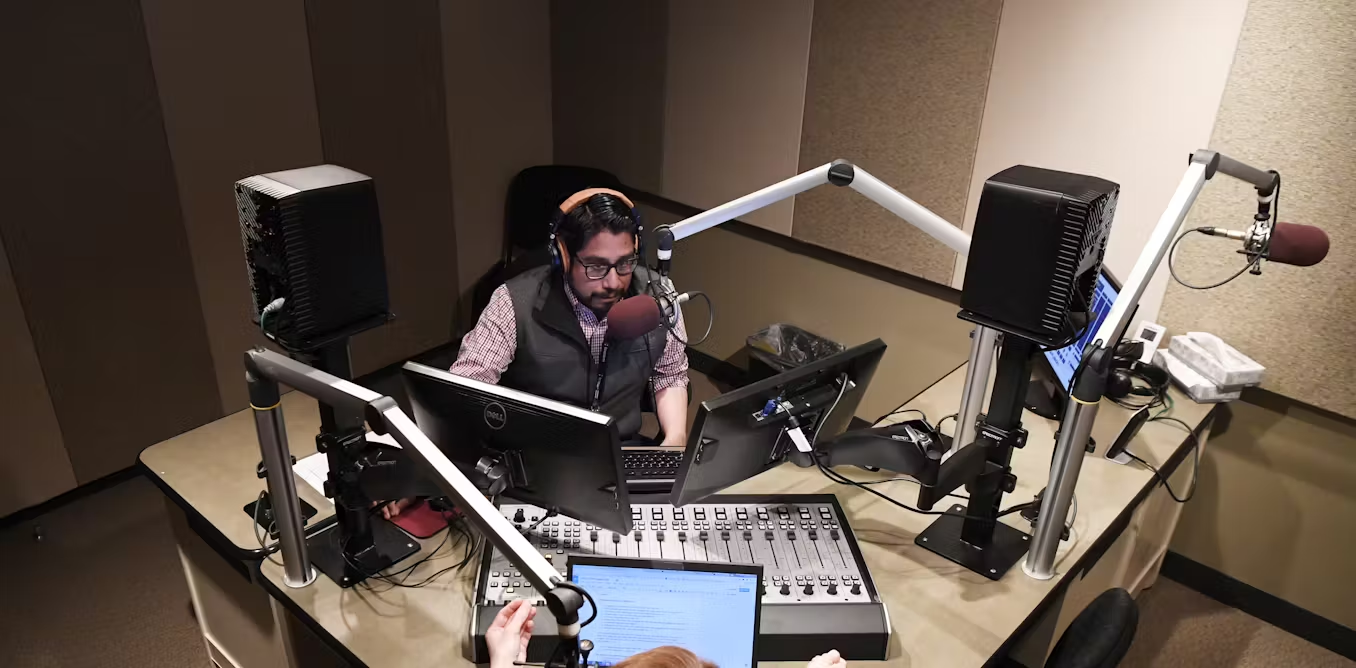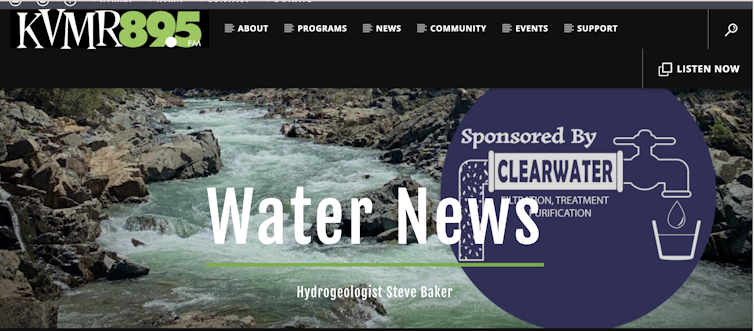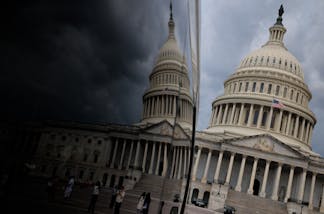 Nathan Heffel and Grace Hood rehearse their Colorado Public Radio public affairs program in Centennial, Colo., in 2017. Andy Cross/The Denver Post via Getty Images –
Nathan Heffel and Grace Hood rehearse their Colorado Public Radio public affairs program in Centennial, Colo., in 2017. Andy Cross/The Denver Post via Getty Images –
In addition, it makes deep foreign aid cuts. All Democrats present voted against the measure in both chambers. They were joined in the Senate by two Republicans: Sens. Susan Collins of Maine and Lisa Murkowski of Alaska. Two House Republicans also voted no: Michael R. Turner of Ohio and Brian Fitzpatrick of Pennsylvania. The Conversation U.S. asked Allison Perlman and Josh Shepperd, who are both media scholars, to explain why the measure will have a big impact on public broadcasters.
What will happen to NPR, PBS and local stations?
NPR and PBS provide programming to local public television and radio stations across the country. The impact on them will be direct and indirect.
Both NPR and PBS receive money from the Corporation for Public Broadcasting, an independent nonprofit corporation Congress created in 1967 to receive and distribute federal money to public broadcasters. More than 70% of the money it distributes flows directly to local stations. Some stations get up to half of their budgets from the CPB.
But NPR and PBS get much of their funding from foundation grants, viewers’ and listeners’ donations, and corporate underwriting. And local public radio and TV stations also get support from an array of sources besides CPB.
–
Only about 1% of NPR funding, and 15% of PBS funding, comes directly from the government via the CPB. However, once local radio and television stations lose federal funding, they’ll be less able to pay NPR and PBS for the programs they produce.
The nearly 1,500 public media stations in the U.S. rely on a mix of NPR, PBS and third-party producer programming, such as American Public Media and PRX, for the programs they offer. Local stations also produce and air regional news and provide emergency broadcasts for the government.
In rural areas with few broadcast stations and spotty cellphone coverage, public broadcast stations are vital sources of information about important community news and updates during emergencies. Federal support is essential for the programming and day-to-day operations of many local stations and allows for the maintenance of equipment and personnel to operate these vital community resources.
We believe that stations in communities that most need them, especially in rural locations, will be hit especially hard because they rely heavily on CPB funding.
Why are Republicans taking this step?
Public broadcasting has long been a target of conservative Republicans.
They say that with a highly diversified media landscape, the public no longer needs media that is subsidized by federal dollars. They also claim that public broadcasting has a liberal bias and taxpayers should not be required to fund media that slants to the left politically.
Why is public media necessary when there’s news on the internet?
As journalism revenue has plummeted, public broadcasting has remained a vital source for news in communities across the nation. This is especially true in rural communities, where economic and political pressures have threatened the survival of local journalism.
In addition, with much online news coverage placed behind paywalls, public radio and television plays an important role in making quality journalism available to the American public.

–
Why did Congress approve these funds 2 years ahead?
Public broadcasting has gotten roughly $550 million per year from the federal government in recent years.
The CPB has always approved and designated those funds two years in advance, due to a provision in the Public Broadcasting Act of 1967, after Congress has voted to provide that money. The CPB then has distributed that funding primarily through grants to PBS and NPR affiliate stations to support their technical infrastructure, program development and audience research.
What are the consequences for Native communities?
Dozens of Native American stations are at risk of closing once the CPB is defunded. Native Public Media, a network of 57 radio stations and four TV stations, is a key source of news and information for tribal communities across the nation and relies on CPB support.
U.S. Sen. Mike Rounds, a South Dakota Republican, publicly stated that he secured an agreement with the White House to move $9.4 million in Interior Department funding to two dozen Native American stations. But there is no provision related to this promise within the legislation.
This article was updated after the House passed the measure.
–
- PBS
- Public broadcasting
- US Congress
- Native Americans
- NPR
- Local media
- Corporation for Public Broadcasting
- Nonprofit media
- public media
- Spending priorities
- Philanthropy and nonprofits
- National Public Radio
- rural media
- US budget 2026
–
Authors Disclosure Statement
Allison Perlman is the co-chair of the Scholars Advisory Committee of the American Archive of Public Broadcasting.
Josh Shepperd and Allison Perlman are under contract to co-author an update of the history of public broadcasting for Current, public media’s trade journal, and the Corporation for Public Broadcasting. Josh and Allison are not paid employees or vendors of either institution.
Partners
University of Colorado provides funding as a member of The Conversation US.
Republish our articles for free, online or in print, under a Creative Commons license.
–
Before you go…
Deciding which causes to support can be overwhelming. Wouldn’t it be easier if you could get trusted information about philanthropy and nonprofits in one place?
That place is the “Giving Today” newsletter. As The Conversation’s Philanthropy + Nonprofits editor, I am fortunate to work with my counterparts at the Chronicle of Philanthropy and The Associated Press to produce this weekly email.
Every week, we team up to send a newsletter that brings together the best of our coverage on these important issues, plus useful articles from other news outlets.
–
Want to write?
Write an article and join a growing community of more than 207,700 academics and researchers from 5,257 institutions.














Comments are open on selected articles and must comply with our community standards.
–